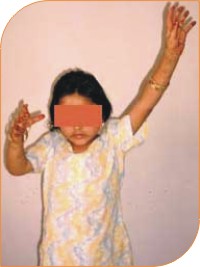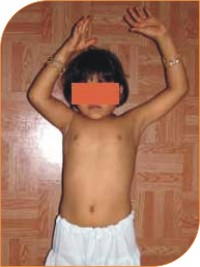If your newborn can move one arm but not the other, he or she may have a condition called Erb's palsy. The inability to move the arm is a symptom of an injury to the brachial plexus (BRAY-key-el PLEK-sis), a network of nerves that provides movement and sensation to the arm, hand and fingers. One or two of every 1,000 babies have this condition. Most infants with Erb's palsy will recover both movement and sensation in the affected arm without surgery. But parents must be watchful and active participants in the treatment process to ensure maximum functional recovery.
How it happens
The nerves to the arm, hand and fingers exit the spinal cord between the bones (vertebrae) of the neck and travel into the arm below the collarbone (clavicle). The nerves to the arm exit high in the neck; those that go to the hand and fingers exit lower in the neck, just above the chest. These nerves branch and join together near where the neck joins the shoulder, in an area called the brachial plexus.
Brachial plexus injuries in newborns usually occur during a difficult delivery, such as with a large baby, a breech presentation, or a prolonged labor, when the person assisting the delivery must exert some force to pull the baby from the birth canal. One side of the baby's neck is stretched, which can damage the nerves by stretching or tearing them. If the upper nerves are affected, the condition is called Erb's palsy. The infant may not be able to move the arm, but may be able to move the fingers. Injuries that involve both the upper and lower nerves are more severe and result in a condition called global palsy.
There are four types of nerve injuries to the brachial plexus.
- Avulsion injuries. The nerve is torn from its attachment to the spinal cord. This is the most serious type of injury.
- Rupture injuries. The nerve is torn, but not at the spinal cord.
- Neuroma injuries. These injuries result from scar tissue that forms and puts pressure on the nerve.
- Stretch injuries. These injuries, known as neurapraxia (new-rah-PRAK-see-ah) are the most common. The nerve is damaged but not torn. Normally, these injuries heal on their own, usually within three months.
The symptoms of a nerve injury (paralysis and loss of feeling) are the same, regardless of the type of injury. However, the severity of the injury does affect both treatment decisions and the extent of recovery possible.
Diagnosis
A newborn with Erb's palsy will have the arm straight down at the side and will not move it. Sometimes, the arm may be slightly turned, with a bent wrist and straight fingers. A droopy eyelid on the affected side may indicate a more severe injury. The doctor may order an X-ray or magnetic resonance image (MRI) to see if there is any damage to the bones and joints of the neck and shoulder. The doctor may also use an electromyogram (EMG) or nerve conduction studies (NCS) to see if any nerve signals are present in the upper arm muscle.

Because most newborns with Erb's palsy recover without surgery, your baby will be examined again at one month and at three months to see if the nerves are recovering by themselves. It may take up to two years for complete recovery. During this time, range of motion exercises is very important to keep the baby's joints from getting stiff.
Treatment
If there is no change over the first three months, nerve surgery may be helpful. However, nerve surgery will not restore normal function or help infants over one year old.
Because nerves grow at a rate of one inch per month, it may take several months, or even years, for nerves repaired at the neck to reach the muscles of the lower arm and hand.
Some children with brachial plexus injuries will continue to have weakness in the shoulder, arm or hand. They may find it difficult to raise the hand over the head, to turn the hand palm up, or to extend the wrist. In some of these cases, a surgical procedure called tendon transfer may be helpful. Tendons are the connective tissues between muscle and bone. The surgeon will separate the tendon from its normal attachment and reattach it in a different place. This is often helpful in improving shoulder and wrist motions as well as elbow position and hand grip.
Tendon transfers are generally performed when the child is old enough to follow instructions. After surgery, the child will have to wear a cast for about six weeks and a splint at night for up to six months. Physical therapy may continue for up to one year after surgery.
 
Difficulty in raising arm After tendon transfer surgery
Your doctor will discuss the various treatment options with you and make a specific recommendation based on your child's individual situation. Do not hesitate to ask questions; there is much that parents can do to help ensure a good functional outcome.
Parents participation
Because your baby cannot move the affected arm alone, it is important that you take an active part in keeping the joints limber and the functioning muscles fit. Your doctor will recommend physical therapy and range of motion exercises. Do these exercises with your baby every day, two or three times a day, beginning when your baby is about three weeks old. The exercises will maintain a range of motion in the shoulder, elbow, wrist and hand and prevent the joint from becoming permanently stiff, a condition called a joint contracture.
Sometimes, the affected arm is noticeably smaller than the unaffected arm. This occurs because the arm is not used as much. Although the size difference is permanent, it will not increase with age. You should also remember that your child is very adaptable. Be supportive and encouraging; focus on what your child can do. This will help your child develop a healthy sense of self-esteem and adjust to any functional limitations. |

